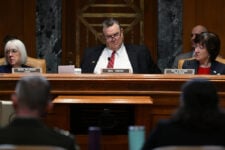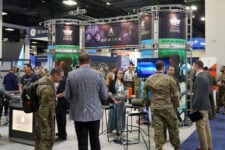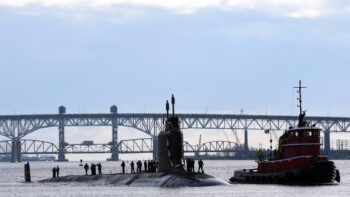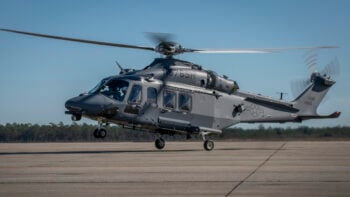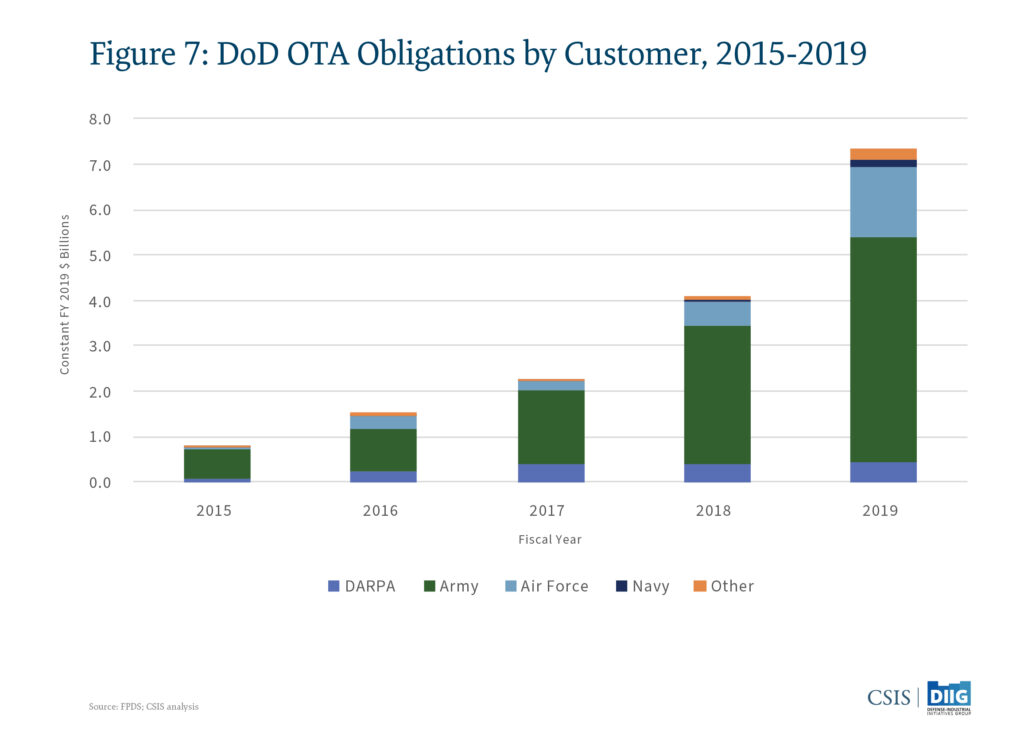
The Army remains the leading user of Other Transaction Authority, but the other services are starting to catch up. SOURCE: Center for Strategic & International Studies (CSIS)
WASHINGTON: The Pentagon’s use of Other Transaction Authority, which bypasses a sclerotic contracting system, rose 75 percent in fiscal 2019 alone, according to a new analysis of Defense Department data by the Center for Strategic & International Studies. Since 2015 – the year Other Transaction Authority first took off, spurred on by congressional reforms – the annual value obligated under OTAs has soared 712 percent.
CSIS scholar Rhys McCormick delved deep into the Federal Procurement Data System database to come up with both those staggering big-picture trendlines and some intriguing caveats.
Perhaps most important, there are some signs the Other Transaction gold rush is cooling off. While the number of dollars DoD actually obligated (i.e. legally committed to pay) under OTAs continues to rise, 2019 actually saw a steep drop in the maximum potential value – i.e., the sum that DoD would spend if it exercised every option in those agreements – from $28 billion in 2018 to $17.8B in 2019, a 37 percent decline. “While this does not suggest that OTAs are falling out of favor,” McCormick wrote, “it might suggest that the exponential growth seen in DoD OTA obligations since FY 2015 might start slowing down.”
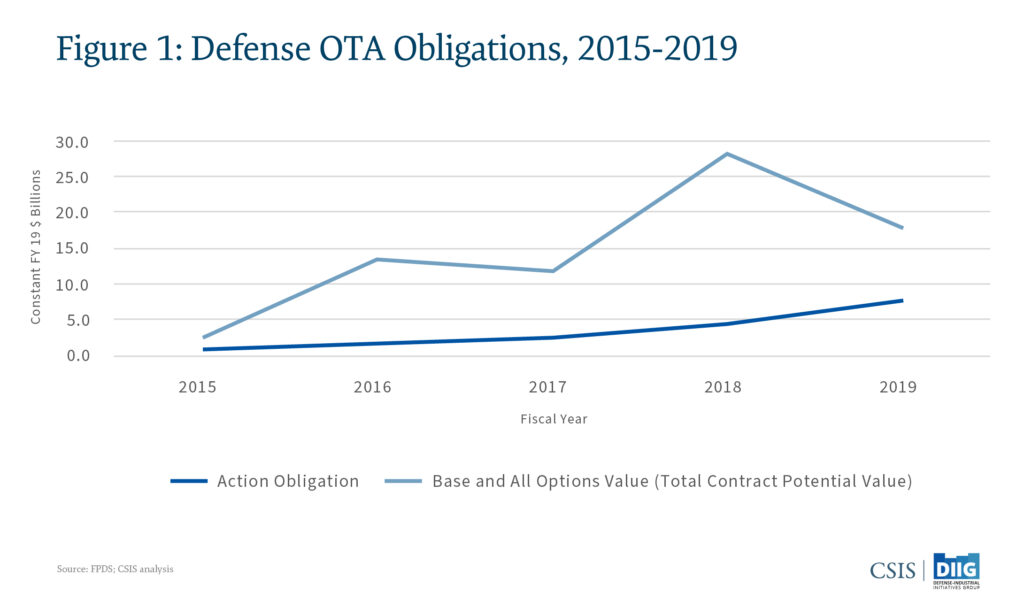
While the amount actually obligated under OTAs continues to rise, the total potential value (counting all options) has declined. SOURCE: Center for Strategic & International Studies (CSIS)
Nor is the adoption of OTAs anywhere near even across the military. The Army remains by far the heaviest user of Other Transaction Authority, led by Army Contracting Command’s Picatinny Arsenal branch, which pioneered the use of OTAs for weapons & ammunition and still accounts single-handedly for 45 percent of all OTA obligations across the Department of Defense. Overall, the Army still accounts for 67 percent of OTA obligations, the Air Force for 21 percent, DARPA for 6 percent, and the Navy for just 2 percent. (Marine Corps OTAs are counted under the Navy Department figure; other DoD agencies round out the total to 100 percent)..
Now, the other services’ totals have started growing a lot faster than the Army’s, but since they were so much lower to begin with, the dollar values are still far from catching up. Army OTA obligations rose from just over $3 billion in 2018 to just under $5B in 2019, a 61 percent increase. Meanwhile Air Force OTAs roughly tripled from just $0.5 billion to $1.6B, and Navy OTAs rose a whopping 486 percent – but since the Navy’s 2018 figure was just $30 million, that surge still left them at just $0.17 billion.
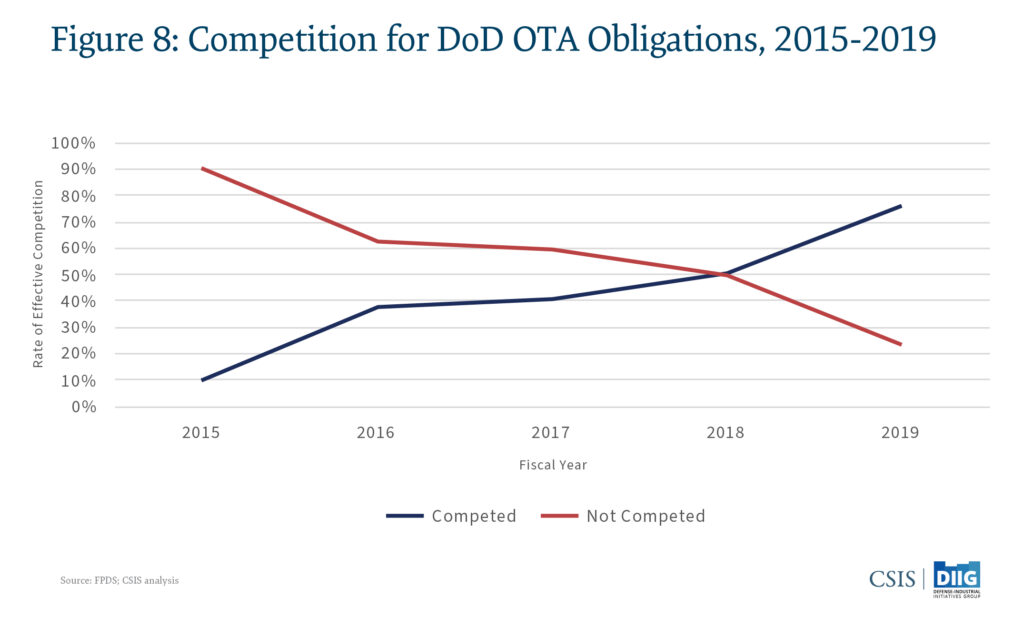
Source: Center for Strategic & International Studies (CSIS)
Who gets all this money? As Congress intended, most OTA contracts still go to “non-traditional vendors” – from startups to universities – outside the established defense industrial base. (DoD normally deals with such vendors via large public-private consortiums, rather than directly one-on-one). But the traditional titans are slowly clawing their way in, driven in large part by their ability to put up their own money and then share costs in a way small firms can’t match.
In 2015, 96 percent of OTA obligations had “significant participation” by non-traditional vendors, while just 4 percent involved cost-sharing; that balance has since shifted to 86 percent non-traditionals vs. 14 percent cost-sharing. That shift to larger vendors may be tied to the increasing average size of OTA awards, which more than quadrupled over five years, from $1 million in 2015 to $4.4 million in 2019.
On the other hand, Congress will be pleased that OTA awards have become more competitive, with a marked decline in sole-source awards. “In FY 2015, just 10 percent of DoD OTA obligations were awarded after competition,” McCormick found. “The share of DoD OTA obligations awarded after competition has risen every year since, and 76 percent of DoD OTA awards were awarded after competition in FY 2019.”
Congress also wanted OTAs to speed up research & development, tightly restricting their use outside R&D. That line has largely held, McCormick wrote: “On average, 82 percent of total DoD OTA obligations were awarded for R&D, compared to 9 percent each for products and services.”
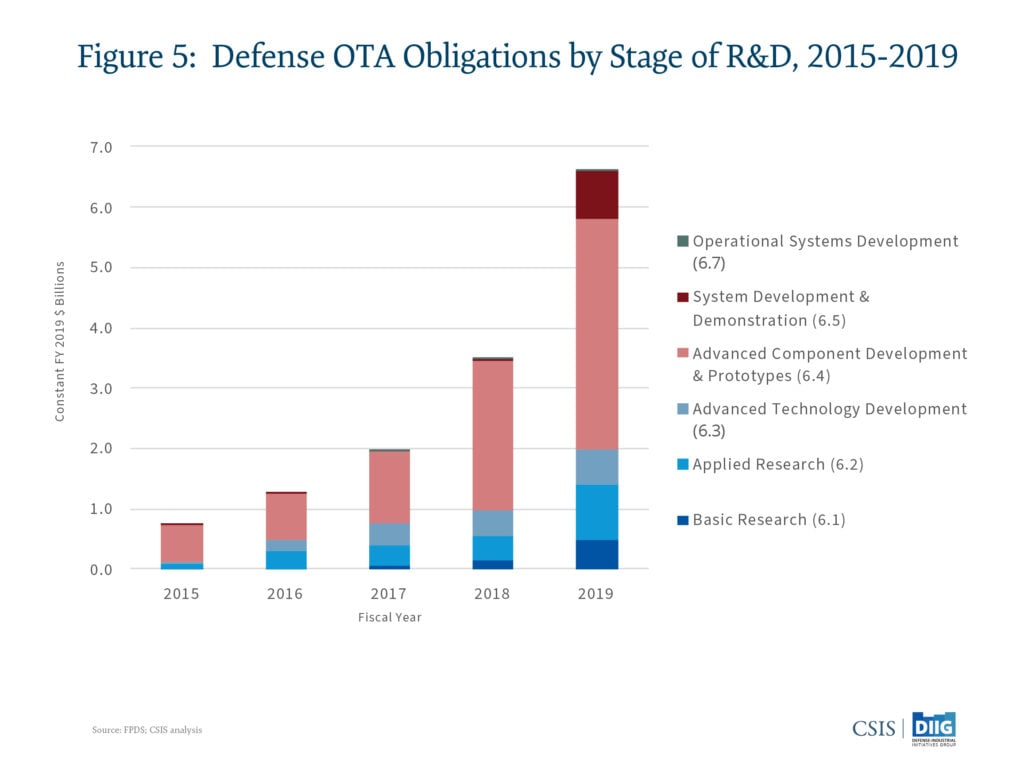
Source: Center for Strategic & International Studies (CSIS)
In the R&D world, in fact, Other Transaction Authority is rapidly moving from alternative to mainstream, McCormick argued. OTAs made up just 3 percent of DoD R&D spending in 2015; in 2019, it was 18 percent. Much of that OTA funding was concentrated, not in the earliest phases of basic research, but in what McCormick called the “mid-to-late stages of the development pipeline for major weapons system,” like prototyping and system demonstrations.
18 percent is still a fraction of military research & development, let alone the overall Pentagon budget, which is dominated by procurement, personnel costs, and day-to-day operating expenses like fuel and food. But it’s a fraction with an outsize impact on the future of defense.
Click here to read the full CSIS report, with many more facts, figures, & graphics.
Air Force nears Wedgetail deal with Boeing after jostle over costs
“We think we can substantially improve over what Boeing offered us. I would say we will not meet in the middle,” said Air Force acquisition czar Andrew Hunter.

